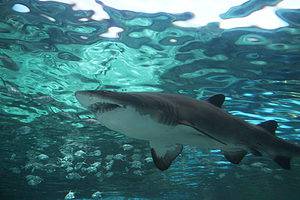Key Facts
- Sharks can grow to impressive sizes with a Great White being capable of reaching 20 feet and a Greenland Shark 21 feet.
- Generally, these marine hunters live for 20 – 30 years, although certain species can live a lot longer.
- Some species are capable of reproducing solo, i.e., parthenogenesis. Examples include blacktips, bonnetheads, and zebra sharks.
One of our most fascinating sea creatures is the shark. We swim with them without even knowing how close they are. We love watching movies, hearing survival stories, and we even become adventure seekers going underwater in shark-infested territory to catch a glimpse of one. We even have a dedicated Shark Week in July for watching all things shark!
The sharks that come to mind are very different from some of their more ancient ancestors. Scientists estimate over 500 species of sharks in existence today.
But you may be surprised just how long some sharks can live! Below you’ll find 10 of the oldest sharks of all time, with the oldest shark living to an age that may exceed 500 years!
10.) Leopard Shark

Leopard
sharks can live up to 30 years!
©evantravels/Shutterstock.com
The leopard shark’s lifespan reaches up to 30 years and is recognizable by the large dark spots on the dorsal side. These sharks don’t migrate but prefer to stay in one particular area. The result is some genetic differences between groups living in various regions.
Leopard sharks are thought to be harmless as a shark species. They are smaller and easier to catch for food and captivity. You are likely to see a leopard shark in an aquarium since they are a slow-growing species.
The Leopard shark matures at age ten and has a gestation period of 10-12 months. When they give birth, their litter may be between 4 and 33 pups 8-9 inches long each. They prefer inlet areas of the Pacific Ocean between Oregon and the Gulf of California. They are large in numbers along the coast in the summer months, most of these being pregnant female sharks.
The leopard shark has no known fatal attacks on humans. Most “attacks” are just bumping as they swim past humans swimming in the ocean. Humans eat more leopard sharks than leopard sharks attack humans. However, the leopard shark has a high level of mercury in its flesh, so regular consumption of this shark is not recommended.
9.) Hammerhead Shark
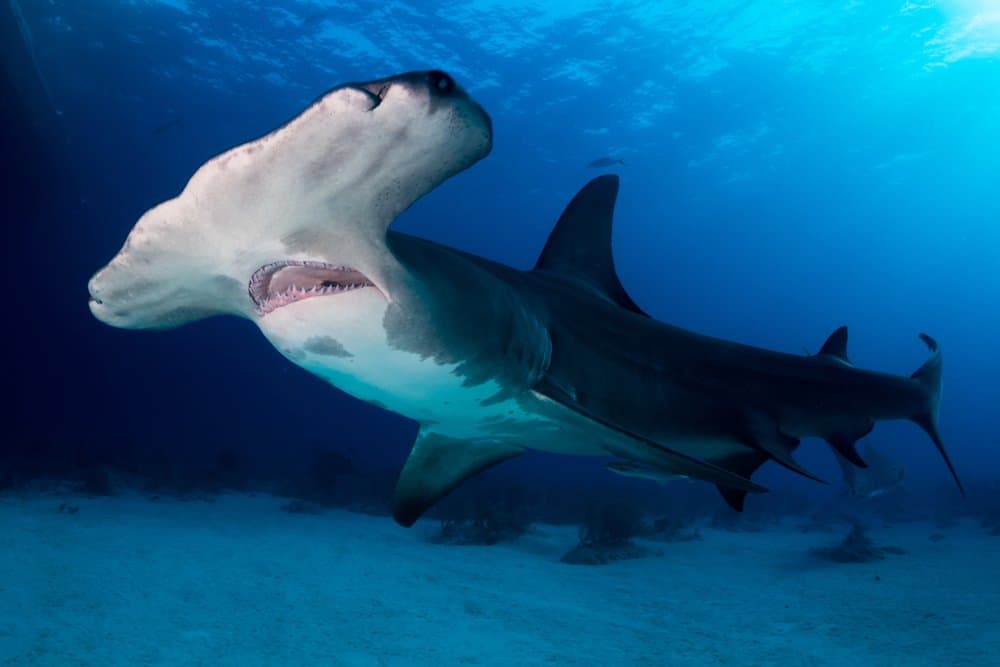
Hammerhead Shark (Sphyrna zygaena) – swimming in ocean
©HakBak/Shutterstock.com
The hammerhead shark is a shark we see today with fossil records dating back to the Cretaceous period. Part of their evolution was the shark growing to smaller sizes, allowing more energy for reproduction instead of size. The name, Hammerhead, indicates the flat T-shaped head of this species. This shape gives the shark the ability to make sharp turns and more knowledge about its environment.
This shark’s lifespan reaches an estimated average 25-30 years, but some individuals have lived up to 44 years! There are nine different hammerhead species; the winghead shark, scalloped bonnethead, whitefin hammerhead, scoophead, great hammerhead, bonnet smalleye hammerhead, and the smooth hammerhead. Interestingly, the hammerhead sharks swim in schools during daylight hours, but they separate to hunt alone at sundown.
8.) Sand Tiger Shark
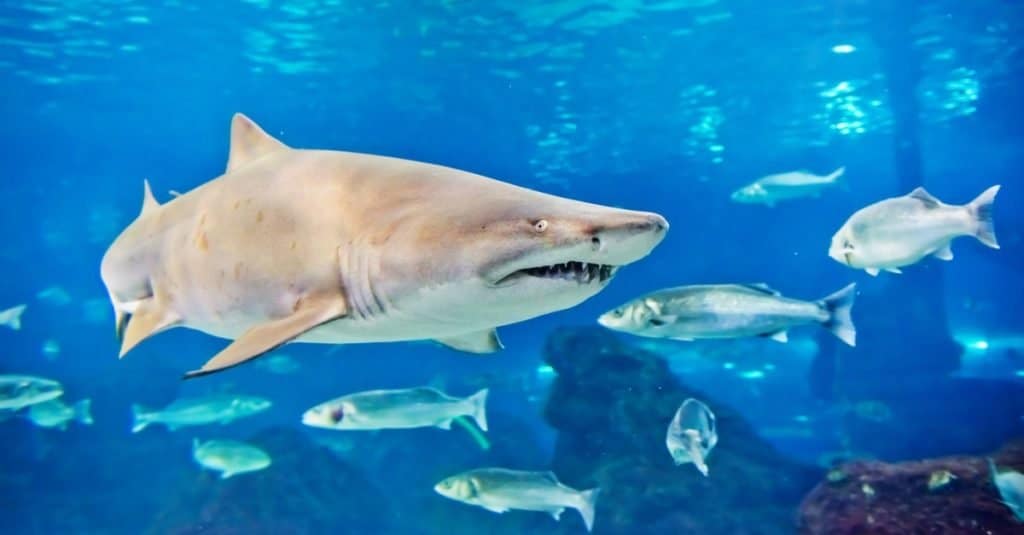
Sand
tiger shark
(Carcharias taurus) swimming with other fish in an aquarium.
©Valeri Potapova/Shutterstock.com
In 2008, a sand tiger shark died at the New York Aquarium on Coney Island. The sand tiger shark — named “Bertha” — was at least 43 years old, making it the one of the oldest known sharks in captivity across the world. Its likely sand tiger sharks in the wild could surpass this age, living 50 years or longer.
Sand tiger sharks are unique among sharks as they can float motionless and ambush prey.
How do they achieve this? By swimming to the surface and taking a gulp of air (they’re the only sharks to do so).
Other interesting facts about sand tiger sharks include their fondness for hanging close to seabeds near the shore, an occasional preference for hunting in groups, and their ability to grow between 6.5 -10.5 feet in length and 200 – 350 pounds in weight.
The species lives in the water off every continent except Antarctica and is especially common in shipwrecks off the Carolina coast.
7.) Dusky Shark
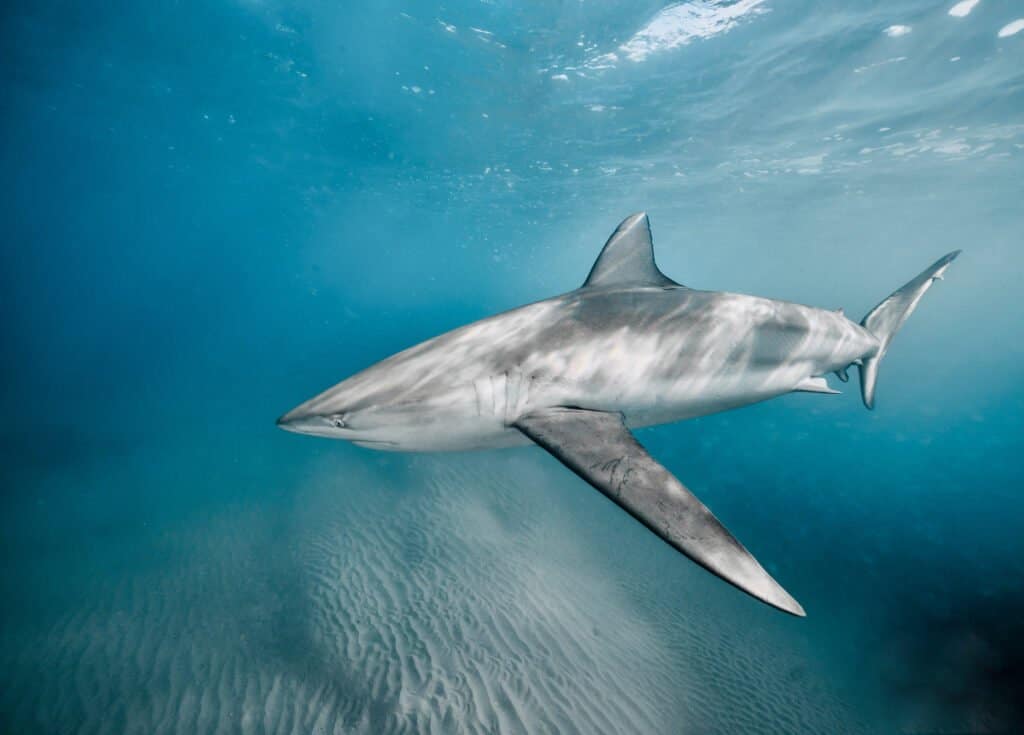
A dusky shark swims in the Mediterranean Sea
©sirtravelalot/Shutterstock.com
With a 35-50 years lifespan, the dusky shark is one of the most vulnerable species of shark worldwide. The long lifespan combined with a prolonged reproductive rate means this species is susceptible to depletion. Fishing for the dusky shark is banned, but they are still caught by accident in fishing gear. In Asia, the fins are used for shark fin soup, making the dusky shark a sought-after species.
The Dusky shark does not attack humans but is considered dangerous because of its large size and desire to swim close to shore. Females stay close to home to give birth which happens once every three years. The gestational period is 22 months for the Dusky shark, and they don’t reach sexual maturity until they are 20 years old. The litter of Dusky sharks is six to twelve, and they will stay inshore until they get bigger. They can be eaten by larger sharks but are generally feared when they reach adulthood.
6.) School Shark
Living over 55 years on average, the school shark is also called the tope, snapper, and soupfin. When they migrate, these sharks travel long distances; some tagged sharks have been spotted over a thousand miles from their first spotting.
School sharks are vulnerable, heavily exploited, and widely hunted. The flesh, fins, and liver are eaten worldwide. The liver has a high level of vitamin A, and the fins are dried and sold to markets in Asia.
The school shark prefers cold to warm temperate continental seas. They migrate, and those that have been tagged have traveled from the United Kingdom to Iceland. They feed in open water and near the sea base. In Australia’s fisheries management, where the school shark population is in danger, there are limits on using gill nets and longlines to protect this species.
5.) Porbeagle Shark
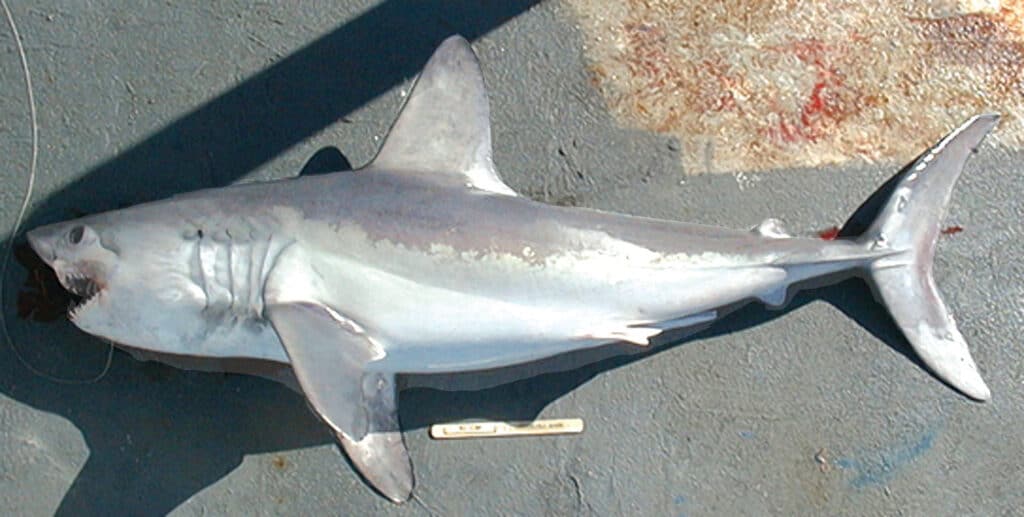
Porbeagle shark close-up
©NOAA, Public domain, via Wikimedia Commons – Original / License
A medium-sized shark species, the porbeagle lives from 30-65 years. It is a recognizable species of mackerel shark. It is known that these sharks are some of the oldest sharks around. They are said to be playful, tugging firmly when fishers get them hooked on their fishing lines. Commercial fishers view these sharks as a nuisance when they steal fish from them, but the hobby fishers love the chase. They are named porbeagle from the combination of porpoise and the beagle.
The porbeagle shark has great endurance swimming large distances for seasonal migrations, feeding, and reproduction. They also need to have a higher body temperature than the surrounding water, accounting for their activity level. This shark will grow to between 4.9 and 6.6 feet long and has no natural predators.
4.) Great White Shark
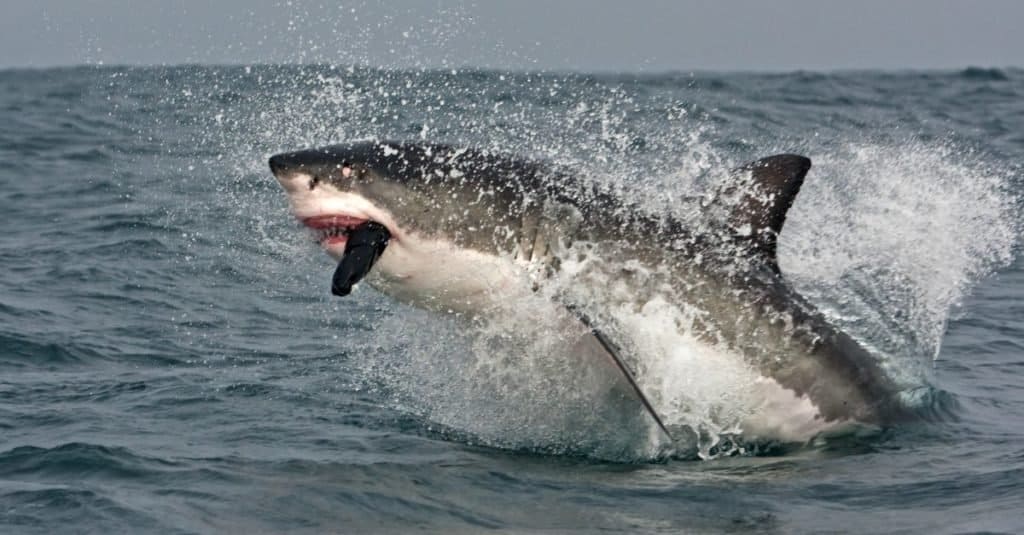
Great white shark, Carcharodon carcharias, with a seal. Great whites can reach speeds up to 24 km/hr (15 mph). They use their speed and coloring to help them hunt. They search for prey at the surface of the ocean while swimming below.
©Martin Prochazkacz/Shutterstock.com
The great white shark‘s life span is nowhere near the Greenland shark. However, it does live an impressive 70 years or more. Like many other sharks, the great white’s age is measured by features like opaque and translucent deposits on the shark’s vertebrae and bands that develop on the shark’s skin related to a shark’s growth rate, much like growth rings in a tree. This is not entirely reliable since the growth rate of sharks slows down as they age.
It was once believed that the great white had a much shorter lifespan. Scientists have learned that it takes longer for the great white to mature. This makes this shark species vulnerable as they are the target of fishermen since it takes longer for the great white to reproduce.
Great whites grow throughout their lives, meaning the largest great white sharks discovered are often 50 years or older. The largest great white recorded — nicknamed Deep Blue — is thought to reach 21 feet in length and weigh 5,000 pounds! Deep Blue’s age has been estimated at 50 years or older.
3.) Spiny Dogfish Shark

Spiny Dogfish (Squalus acanthias) at the south coast of Norway
©Joern_k/Shutterstock.com
Spurdog, mud shark or piked dogfish are other names for the spiny dogfish. A well-known species of the dogfish shark family, this small, slow-growing shark lives between 25 and 100 years. The gestation period is 18-24 months, the longest known animal gestation period worldwide. This is another vulnerable species of shark due to late maturity and more extended reproductive period.
This shark is named dogfish because of its herding pack-like behavior. They will chase down smaller fish and keep them in groups. Schools of the dogfish sharks will gather in numbers in the hundreds, swimming in close groups during the day. They will feed less in the winter months, swimming at 2,900 feet below the surface, but they will return to the surface and warmer waters for their summer feeding in the springtime. The spiny dogfish is considered a venomous shark.
2.) Whale Shark
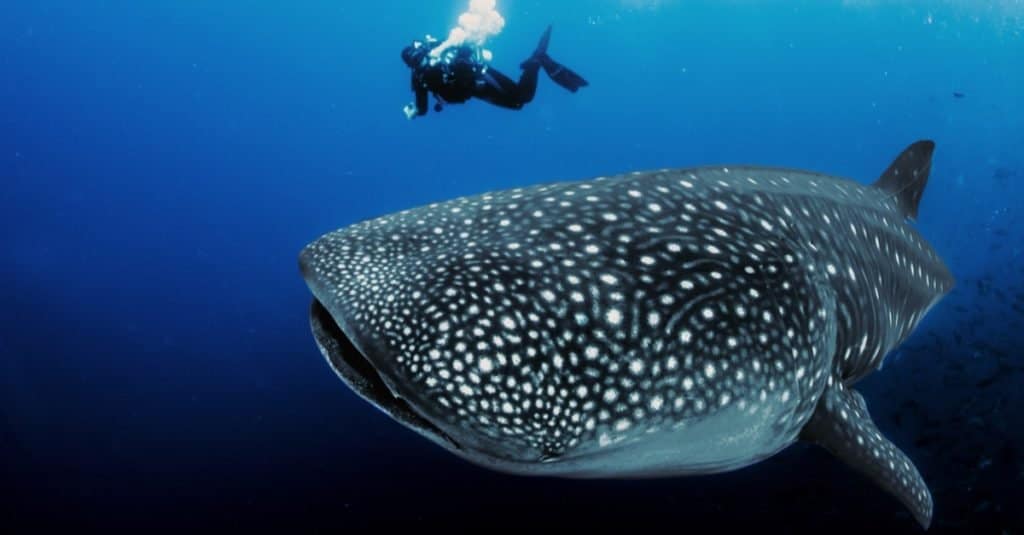
Each whale shark has its own unique pattern of spots, much like human fingerprints. A whale shark’s mouth is about 5 feet wide (1.5 m). They have rows of over 300 teeth, but as filter feeders, they do not use these teeth to eat.
©Lindsey Lu/Shutterstock.com
At an average of 70-100+ years, the Whale shark is the largest existing fish species worldwide. While they do have some characteristics that are common to whales, they are of the shark family.
Dating back to 60 million years ago, these sharks are not a threat or feared by people. They feed almost exclusively on plankton. People are so comfortable with these docile giants, they have been known to swim with the Whale shark in the wild.
Whale sharks will travel considerable distances for food and reproductive habits. They prefer tropical oceans over colder waters. It is thought that these sharks grow to 20m (more than 60 feet) and are distinguishable by the white spots covering their body. The Whale shark likes to feed on the surface but has also been diving as deep as 1000m.
1.) The Oldest Shark in the World: The Greenland Shark!
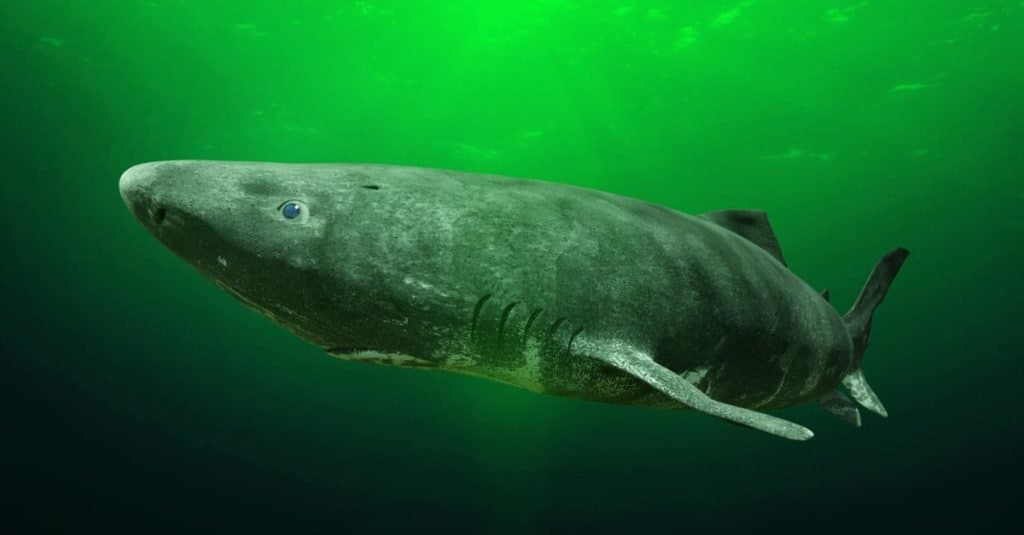
Greenland shark near the ocean ground
©Dotted Yeti/Shutterstock.com
The oldest shark in the world — by a comfortable margin — is the Greenland shark. Its lifespan is at least 250 years, but scientists have estimated this shark may live over 500 years! This shark doesn’t have typical markers scientists use to evaluate age. Instead, they discovered a protein inside the shark’s eyes. The protein is formed before the shark is born and does not degrade as they grow. Scientists have carbon-dated the protein, giving an accurate estimate of age.
We also know that these sharks grow at a rate of less than 1 cm per year yet have been measured at 6 meters long. Using this method, we can estimate age based on the length of the shark. Using either estimate, at the shortest end of the lifespan estimate, the Greenland shark is the longest-lived vertebrate.
A slow metabolism, slow growth, slow aging, sluggish movement, and the ability to withstand the cold temperatures of deep ocean waters help this shark live a long life. Sexual maturity is thought to be about 100 years for this shark. Since there is such a long lifespan, removing even one mature shark takes a toll on the Greenland shark population.
Summary
| Number | Name | Lifespan |
| 1 | Greenland Shark | 250 – 500 years |
| 2 | Whale Shark | 70-100+ years |
| 3 | Spiny Dogfish Shark | 25 – 100 years |
| 4 | Great White Shark | 70+ years |
| 5 | Porbeagle Shark | 30 – 65 years |
| 6 | School Shark | 55+ years |
| 7 | Dusky Shark | 35 – 50 years |
| 8 | Sand Tiger Shark | 50+ years |
| 9 | Hammerhead Shark | 25 – 30 years |
| 10 | Leopard Shark | 30 years |
Up Next…
- The Largest Bull Shark Ever Recorded: Giant predators known to enjoy a varied diet (including other sharks), members of this species are capable of reaching impressive sizes. Find out about the biggest of their kind ever discovered.
- Real Life Jaws Spotted – 30ft Great White Shark By Boat: What if that massive sea monster made the leap from imagination into reality? Here’s one encounter during which it seemed to have done just that.
- Shark vs Octopus: Who Would Win in a Fight? Find out here which cephalopod is most likely to get to swim away once the encounter is over.
Thank you for reading! Have some feedback for us? Contact the AZ Animals editorial team.





